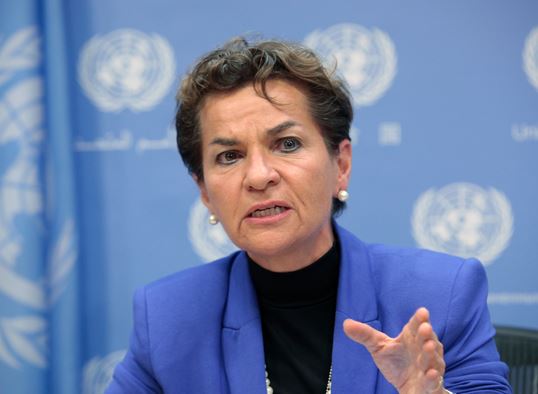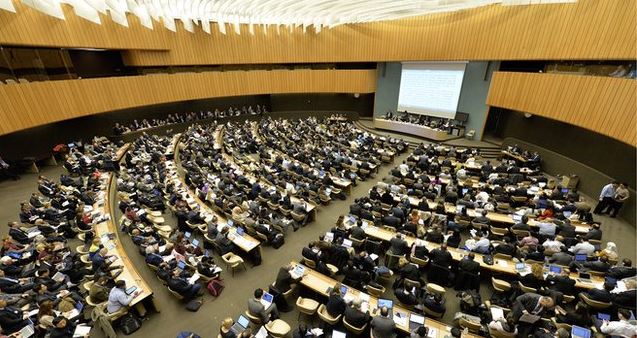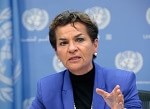More than 190 countries agreed on a draft text in Geneva, Switzerland, on Friday for a deal due at the end of this year to combat climate change. However, they postponed committing themselves to some hard choices about becoming more specific with a broad range of options for reducing the harmful rise in temperatures.
In other words, the draft of the agreement was watered down in an effort to include the priorities of more countries.
The agreement is scheduled to be reached in Paris in November-December and will come into effect in 2020.
Government representatives adopted an 86-page-long draft as the official basis for talks. This new document, which took one week to create, is now twice the size of the previous one.

Christiana Figueres says she was encouraged by the rapid progress over the past week.
Several delegates, who had been hoping the document would become more streamlined, were annoyed the size of the text had doubled in size. Ilze Pruse, a delegate from the European Union, said “We were hoping to see a more concise text.”
The inflated text means that officials worldwide now have much more work to do to narrow down the mountain of options to a single agreement to be signed in December.
While not nailing down countries to any cast-iron agreement, the aim is to phase out net greenhouse gas emissions by the year 2050, and work towards a peak of emissions “as soon as possible”.
Advanced and emerging economies have different priorities
The advanced economies are pushing hard for carbon-dioxide emission curbs to fight climate change, but several emerging economies want more flexibility to bolster energy consumption and rapid growth, as well as funding to help with emissions cuts.
Christiana Figueres, Executive Secretary of the UN Framework on Climate Change (UNFCCC), said:
“I am extremely encouraged by the constructive spirit and the speed at which negotiators have worked during the past week.”
“We now have a formal negotiating text, which contains the views and concerns of all countries. The Lima Draft has now been transformed into the negotiating text and enjoys the full ownership of all countries.”
Ahmed Sareer, a Maldives delegate who represents an alliance of island nations, said:
“After years of false starts and broken promises, restoring ownership and trust in the process is no small achievement. And I think we have come a long way toward doing that.”
According to UNFCCC, the negotiating text covers the substantive content of the new agreement including technology, mitigation, finance, adaptation and capacity-building.
Text now represents more countries’ points of view
Ms. Figueres said the nations worked hard to pinpoint the main choices. They argued their points of view and added more sharpened options to the text.
Ms. Figueres said:
“The text was constructed in full transparency. This means that although it has become longer, countries are now fully aware of each other’s positions.”
The negotiating text will be edited and translated into the United Nation’s official languages and will then be communicated to the world’s capitals by the UNFCCC secretariat in the first quarter of this year.

Most of the delegates at the UN climate talks in Geneva were pleased with the progress made over the past week. (Image: UNFCCC)
Ms. Figueres explained:
“This fulfills the internationally-accepted timetable for reaching a possible treaty because it alerts capitals to the fact that a legal instrument could be adopted in Paris. It does not, however, set this possibility in stone – it merely opens the door for this possibility. As for the legal nature of the agreement, this will only be clarified later in the year.”
Negotiators will next narrow down the options and reach agreement on the content. This will continue until the Climate Change Conference in Bonn, Germany in June, 2015, and at two further formal sessions also in Bonn (August 31 to September 4, and October 19 to 23).
Climate change meetings at ministerial level will take place throughout the year. These include the Petersburg Climate Dialogue, the African Ministerial Conference on the Environment with the upcoming G7 and G20 meetings.
Ms. Figueres said:
“These opportunities will help to ensure that countries have opportunities to work with each other at several political levels–what is needed now is vertical integration so that the views of heads of state, through ministers and to negotiators reflects a seamless and consistent view of ambition, common ground and ultimately success in December.”
Hopefully, a final agreement in Paris
All these talks and meetings that will take place this year will culminate in a meeting in Paris (United Nations Climate Change Conference – November 30 to December 11). Although it is not expected to stop climate change, if agreement is reached it will be the first time all nations have agreed to jointly do something about it. It will replace the Kyoto Protocol international treaty.
The UN talks, which have been slow-moving, received a boost in 2014 when the US and China, the world’s largest polluters, jointly announced pledges to limit emissions for the Paris meeting. The EU and Norway have also put forward targets

